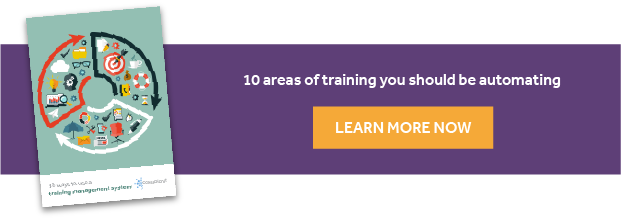How Training Management Software Can Help The HR Team

The mutual benefits of training employees and up-skilling have been well documented. Retention rates rise, motivation is bolstered and productivity heads in the exactly the same direction. Today the question is this: what role is technology and in particular LMS playing in simplifying learning and development, and perhaps more importantly, what should this look like?
Many have implemented elements and levels of learning management systems to increase efficiency and streamline processes, because after all, managing the training schedule for 100’s of employees who are keen to develop their skills and knowledge can be quite an undertaking.
Online booking
Once HR teams would have employees fill out sheets of paper with details of the course they want to attend. That would then get signed off by a manager, and the individual was given access to the training.
Worryingly, some departments may still operate in this way. But, what happens when there’s one place left on a programme, one person applies and whilst in the process of sign off, another person applies? Over-bookings happen all too easily, they cause headaches for everyone involved.
Online booking gives attendee and HR real time information. If there are ten places left on a course, that’s what the system will say. And, if there are ten places left but ten are pending sign off – that’s what the system can report.
Surveys and feedback
The most valuable information around training, for those investing in it, is post-learning. The feedback will make or break the training and development programme – so how does HR collect that vital information, and is it a fair reflection of what happened when it does turn up?
It's been the case in the past that HR teams have relied on handwritten happy sheets (very basic questionnaires) that have been filled out in a rush by delegates heading for the door after an intense two-day learning programme. That makes no sense.
Today HR teams are wising up to the fact that gleaming this information from individuals a day or two after the event, when people are in less of a rush is far more productive. When this process is completed online via a training management system it’s even more effective. HR decision makers can see powerful information at a glance, not have to sift through pages of notes just to see if any patterns or trends are emerging. This is a simple way for HR to earn more return on their training investment.
You can read more about surveys and feedback in this article "The Importance Of Feedback In Training Companies".
e-Learning
The world of learning is ever-changing. Classrooms are not the only option today and now that the benefits of flexible working have been understood, now it’s time to understand the benefits of flexible learning. If employees want to take control of their working week, why shouldn’t they be able to decide when they learn as well? They should, and in many companies they can. Via an e-Learning programme (which can be created and designed by the HR team), individuals can log in and learn at a time that suits them.
If the climb in flexible working practice has taught us anything it’s that people are different, and want to work in different ways. HR acknowledges this and via flexible learning and working, many departments are respecting it too.
Find out more about accessplanit's user portal here.
Course management
No matter how big the group is or the pool of potential learners at your company, training requires management. The extent to how that management becomes a burden on the entire HR team is another matter entirely. HR departments can streamline the management of courses with course management software. What does this actually relate to? Booking classrooms, ensuring that everyone knows where and when to arrive, and joining information are all potential administrative nightmares for HR. Course management software however, allows the function to completely automate.
In one example, a classroom has been booked for 20 employees to learn about a new piece of software that has been developed within the IT department. Five minutes before the event, the company that rents out the classrooms calls to say there is a problem and the class has been moved to a different venue. HR can manage this disruption by automatically sending an SMS text message to all attendees. This course can start on time, and there has been no need to re-schedule any part.
Legal compliance
Particularly important in terms of health and safety is ensuring all employees remain complaint. So, if in a construction company it is necessary for employees operating certain machinery to be tested and qualified at least annually, this will be flagged at an agreed timescale to allow sufficient time to attend a refresher.
Automation removes the need for checklists and spreadsheets and the element of doubt which is risky in business critical areas. Employees are automatically sent joining instructions and can book the course online at their convenience. Training software will also close the loop by notifying trainers and managing all resources associated with each course.
Other related articles include:
Who Choose A Training Management System Over A CRM?
